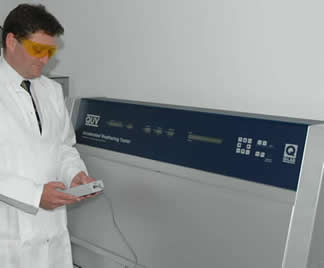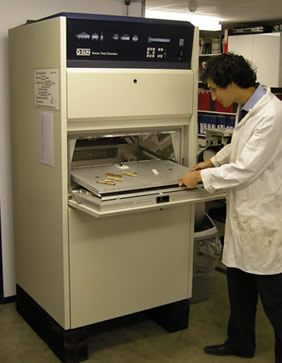Types Of UV Testing Machines
There are several different types of equipment and methods for exposing samples to UV light for the purpose of testing and evaluation of different materials. In general they fall into one of the following categories:
1.0 Fluorescent Bulb Type Machines
2.0 Xenon Arc Type Machines
3.0 Carbon Arc Type Machines
4.0 Outdoor Exposure
Items 1, 2 and 3 can be considered to be true acclerated testing methods. In all cases there are specifications, both international and national, that define the equipment requirements, exposure conditions and control parameters. Each test type has pros and cons and these are discussed more fully below.

Fluorescent Bulb Type Machines (QUV)
As the name suggests these machines are based on the use of special fluorescent bulbs (similar to strip lights) that emit a very controlled spectrum of light within the UV spectrum of interest. Most machines also combine this with a controlled level of heating and some form of moisture on the samples. This can take the form of either a water spray or a water condensation cycle. The intensity of the UV light can also be varied but is normally defined in the standards. The total duration of the UV and the water elements can be varied to give various cycles. Once again these are normally defined in the relevant standards. A typical cycle is 8 hours of UV followed by 4 hours of condensation. During this cycle the temperature would vary from 60C during the UV portion of the cycle to 50C in the condensation phase.
It is the combination of heat, light and condensation the produce the acclerated UV ageing and also minics real life conditions. Even in hot environments products will typically get condensation on their surfaces at night or early morning and it normally takes considerable time for this to dry off.
Fluorecent bulb type machines often have a variety of bulbs to select from which give various different outputs. The most common bulb type is referred to as the type A bulb. This is more correctly known as the UVA340 bulb. This should not be confused with the UV A part of the solar spectrum (see more about solar spectrum under the learn more tab). This bulb type very accurately reproduces the UV portion of the solar spectrum from about 300-390 nm. For this reason the fluorescent bulb type test is one of the most accurate in this region.

An alternative bulb in this machine is the UVB 313 bulb. This bulb tends to be used for quality control purposes or where very fast results are required. It produces a much high intensity than normal sunlight and exposes the samples to a higher intensity of the very short wavelengths. For this reason it may produce degradation that is not normally seen in real life but for quality comparisons it can be useful.
Because the intensity and the output of the bulbs change with time the irradiance needs to be continually monitored or the bulbs cycled and changed at regular intervals. Materials Technology utilises the newest types of machines fitted with continual solar irradiance monitoring and control (solar eye). This provided superior and more reproducible results when compare to the older style machines that rely on bulb cycling.
Fluorescent bulb type testing tends to be one of the most ecconomical types of testing and single samples or multiple samples can be exposed at any one time.
Xenon Arc Machines (Q-Sun & Atlas Weathometers)
These machines are based on the use of a noble gas (Xenon) which is sealed in a quartz tube to produce an arc light. The advantage of the Xenon arc is that it reproduces the complete of sun light spectrum from UV right through to visible and infra-red. Whilst UV wavelengths are typically the most damaging to polymers, xenon arc lamps are the best way to test products such as pigments, dyes and inks, which may be sensitive to the longer UV wavelengths, visible wavelengths of sunlight and Infra-red radiation. Xenon arc testing is most often used for industries where colour change is a key factor, as other pure UV tests may not accurately show how a sample will discolour.

Materials Technology offer xenon arc testing to many different standards and specifications and offer two different size of machine depending on your requirements, which use either 1 or 3 x 1800W Xenon arc lamps.
Our larger test machine can run a humidity cycle, an uncommon feature in Xenon Arc Machines. The humidity cycle feature means that the Q-Sun machine can effectively recreate a tropical type environment. It also features a customisable spray cycle which can apply ‘rain’ to the specimens, at any point during the cycle. The water used in the spray and humidity cycles is deionised and of a purity of less than 1 PPM total dissolved solids to avoid water spotting on the samples.
Tests typically run at a black panel temperature of 65ºC an air temperature of 38ºC and an irradiance of 0.55 W/m2, however all of these can be varied according to test requirements. Our larger test machine has a specimen tray capacity of 451x718mm.
The smaller machine has a capacity of 251x457mm. This machine has an integrated chiller and can run a spray cycle but does not feature humidity control.
Pricing of xenon arc testing is based on a per hour charge for the whole chamber rather than a per sample basis. Hence this testing can be very economic for larger volumes of samples.
Carbon Arc Machines
Carbon Arc machines are discussed in more detail under our history of testing section. These machines were some of the first UV testing machines and are still used to a more limited degree today. Like Xenon arc they produce a broad spectrum of light which needs to be filtered and is not as accurate in the UV portion of the spectrum. Materials Technology can not offer in house testing with this equpment but we are able to offer this through some of our affiliate labs.
Outdoor Weathering
Real life outdoor weathering typically involves exposing samples to real outdoor conditions for very long durations in places with intense sunlight. This tends to be Florida or Arizona and hence is often referred to by these acronymns. Samples are simply laid out on racks at the relevant angle to the sun and monitored for degradation. Even in these hot climates results may take 3 or 4 years to become apparent and hence are often not practical for most manufacturing operations. Another disadvantage of outdoor exposure is that reproducibility can be poor. Even in climates which are considered to be relatively stable the actual weather conditions can vary significantly from day to day and pollution can play an important part in variation. Laboratory controlled tests tend to be more reproducible as all conditions are finely controlled.

Outdoor exposure testing can also be combined with solar collectors that focus and or track the sun to give a higher intensity of exposure. This often results in significant sample heating and therefore is somewhat limited in acceleration factors. Materials Technology can not offer in house testing with this equpment but we are able to offer this through some of our affiliate labs or can provide additional testing advice.
